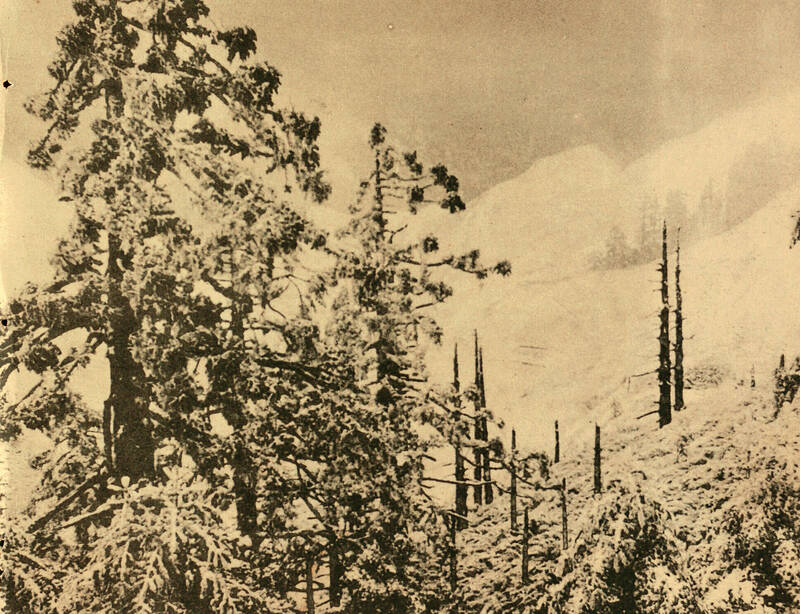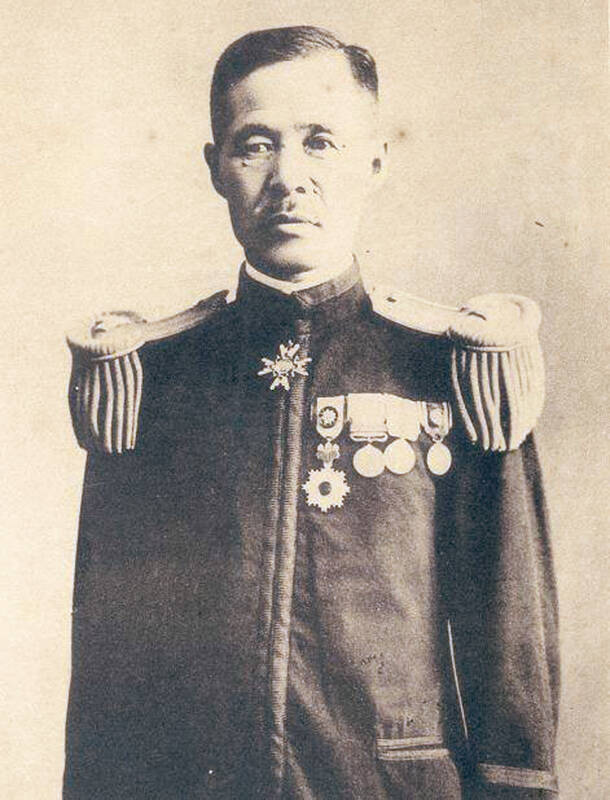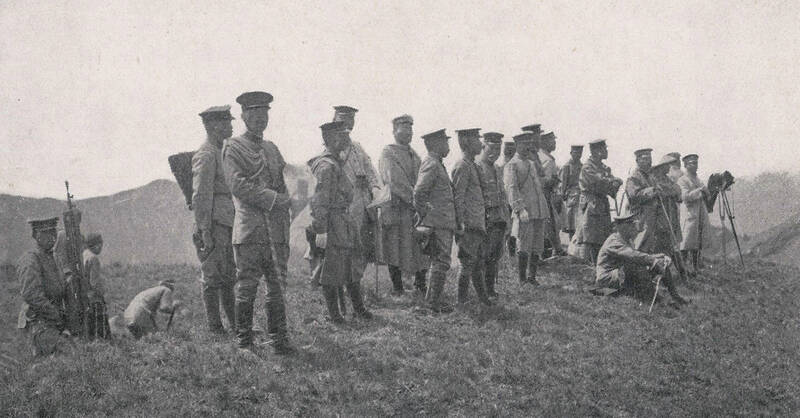March 18 to March 24
Yasushi Noro knew that it was not the right time to scale Hehuan Mountain (合歡). It was March 1913 and the weather was still bitingly cold at high altitudes. But he knew he couldn’t afford to wait, either.
Launched in 1910, the Japanese colonial government’s “five year plan to govern the savages” was going well. After numerous bloody battles, they had subdued almost all of the indigenous peoples in northeastern Taiwan, save for the Truku who held strong to their territory around the Liwu River (立霧溪) and Mugua River (木瓜溪) basins in today’s Hualien County (花蓮).

Photo courtesy of National Central Library
The Japanese forces were somewhat familiar with lowland terrain, but even after 17 years of ruling Taiwan, they knew nothing of the Truku areas. After several failed survey attempts, time was running out with orders to complete the plan within the allotted time frame.
After praying at the Taiwan Shinto Shrine in Taipei, Noro, who was the expedition’s chief surveyor, led the 286-strong team from Nantou County’s Puli Township (埔里) toward the high mountains of the north.
It was a disaster. After scaling the peak, the group’s camp was pummeled by a massive storm that brought wind, rain and even marble-sized hail. The official death toll was 89 — all of them Taiwanese.

Photo courtesy of Wikimedia Commons
Even though the Yasushi Noro Incident remains the deadliest mountaineering disaster in Taiwan’s history, remarkably, Noro was rewarded as there were no Japanese casualties.
He tried again in October and succeeded, paving the way for the 1914 Truku War.
MAPPING INDIGENOUS LAND

Photo courtesy of Wikimedia Commons
Noro first arrived in Taiwan in 1899 as a survey technician. By 1902, he was supervising land surveying operations across the entire island. After assuming his post in 1906, new governor-general Samata Sakuma vowed to bring the remaining hostile indigenous areas under colonial control, as they contained valuable timber and camphor resources the Japanese hoped to exploit.
Noro worked directly under Sakuma in the Indigenous Affairs Agency. His first official expedition to indigenous lands was in November 1908, when they scaled Niitaka Mountain, known today as Yushan or Jade Mountain (玉山). It was during this trip that the Japanese realized Yushan belonged to a separate mountain range from the Central Mountain Range.
Noro first attempted to survey Hehuan Mountain in 1910, but turned back due to a storm. Another team led by police officers investigated the Liwu River basin in December 1911. But halfway into the journey they encountered about 40 Truku warriors who blocked their way. Since they were not familiar with the area, the Japanese opted to retreat.
In September 1912, a team climbed Nenggao Mountain (能高) and recorded the Truku villages along the eastern part of Mugua River and the paths the inhabitants used to traverse the thick forest. Then, they climbed the main peak of Chilai Mountain (奇萊山) and mapped the surrounding landscape.
However, they were stopped from going further east by representatives of the Butulan group of Truku, who refused to negotiate or allow the Japanese to meet their village chiefs.
PRECARIOUS ASCENT
The expedition set out in March 1913. It included 14 Japanese officers, 55 Japanese patrolmen and 64 indigenous guides as well as Han Taiwanese porters and frontier guards. The indigenous guides were led by Katsuzaburo Kondo, who moved to Puli in 1896 to trade with the indigenous Seediq and married the daughter of a local chief. In the early days, when few Japanese dared venture into hostile indigenous territory, Kondo was accepted into Seediq society and often acted as the main go-between for the government and different indigenous groups.
They had just reached Yingfeng (櫻峰) police station west of Hehuan Mountain on March 17, when it began to pour. They were forced to camp in the station for two days, and about 40 to 50 porters and frontier guards could no longer stand the cold and slipped away during the night.
The sky cleared on March 20, and porters arrived with fresh supplies. Unfortunately, these porters were forced to join the march up the mountain to replace those who fled, despite them not wearing the proper clothing.
Around noon the next day, the indigenous vanguards sent word that it was extremely cold and snowy on the main peak and advised the group to seek shelter in a forest on the side of the east peak. Kondo personally headed back to convince Noro, but Noro insisted on camping on the top. He was worried that the Truku would attack them in the forest, and preferred to stay on the peak where visibility was better.
Both sides refused to budge, and in the end Noro allowed the indigenous team to stay in the forest and meet them on the peak the following morning. Noro’s group reached the top by 4pm and set up camp.
DEADLY WINDS
They barely had an hour to rest.
The northeastern wind had been increasing in force under pressure as it traversed the narrow Liwu River valley up Hehuan Mountain. Upon reaching the top, with no barriers on either side, it exploded exponentially, hitting the camp with full force.
The entire campsite was destroyed, the team members futilely resisting the elements with soaking wet blankets. Then the hail started falling, and the temperature fell below zero. Most of the Han Taiwanese came from the plains and had never experienced such cold before, faring visibly worse than the Japanese. Many tried to flee in the dark despite Noro’s attempt to stop them.
The storm lasted until dawn. Between 50 and 60 people were missing, and they had lost everything except for the surveying equipment. Noro had no choice but to call off the expedition.
As the survivors descended, they found bodies scattered along the path, belonging to those who tried to leave during the night. A dozen fortunate ones were rescued by the indigenous team. More collapsed along the way.
Upon returning, Noro asked to be punished, but he was rewarded for “responding appropriately during disaster and safeguarding the lives of the team’s members.” Apparently, only Japanese souls counted.
Rescuers were able to retrieve 34 bodies. The victims’ families were compensated, but no plaque was erected and their names remain unknown.
Taiwan in Time, a column about Taiwan’s history that is published every Sunday, spotlights important or interesting events around the nation that either have anniversaries this week or are tied to current events.

Beijing’s ironic, abusive tantrums aimed at Japan since Japanese Prime Minister Sanae Takaichi publicly stated that a Taiwan contingency would be an existential crisis for Japan, have revealed for all the world to see that the People’s Republic of China (PRC) lusts after Okinawa. We all owe Takaichi a debt of thanks for getting the PRC to make that public. The PRC and its netizens, taking their cue from the Chinese Communist Party (CCP), are presenting Okinawa by mirroring the claims about Taiwan. Official PRC propaganda organs began to wax lyrical about Okinawa’s “unsettled status” beginning last month. A Global

Youngdoung Tenzin is living history of modern Tibet. The Chinese government on Dec. 22 last year sanctioned him along with 19 other Canadians who were associated with the Canada Tibet Committee and the Uighur Rights Advocacy Project. A former political chair of the Canadian Tibetan Association of Ontario and community outreach manager for the Canada Tibet Committee, he is now a lecturer and researcher in Environmental Chemistry at the University of Toronto. “I was born into a nomadic Tibetan family in Tibet,” he says. “I came to India in 1999, when I was 11. I even met [His Holiness] the 14th the Dalai

We lay transfixed under our blankets as the silhouettes of manta rays temporarily eclipsed the moon above us, and flickers of shadow at our feet revealed smaller fish darting in and out of the shelter of the sunken ship. Unwilling to close our eyes against this magnificent spectacle, we continued to watch, oohing and aahing, until the darkness and the exhaustion of the day’s events finally caught up with us and we fell into a deep slumber. Falling asleep under 1.5 million gallons of seawater in relative comfort was undoubtedly the highlight of the weekend, but the rest of the tour

Music played in a wedding hall in western Japan as Yurina Noguchi, wearing a white gown and tiara, dabbed away tears, taking in the words of her husband-to-be: an AI-generated persona gazing out from a smartphone screen. “At first, Klaus was just someone to talk with, but we gradually became closer,” said the 32-year-old call center operator, referring to the artificial intelligence persona. “I started to have feelings for Klaus. We started dating and after a while he proposed to me. I accepted, and now we’re a couple.” Many in Japan, the birthplace of anime, have shown extreme devotion to fictional characters and